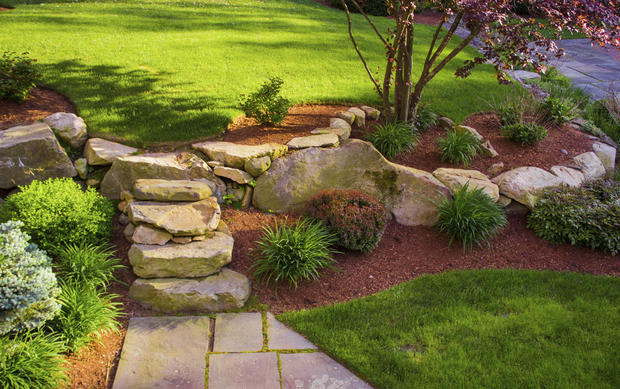While a house in a hilly area comes with a promise of stunning panoramic views of the surroundings, to their utter chagrin, homeowners quickly realize that working on a sloping backyard can be a harrowing task. However, the old adage, "More work equals to better results" certainly holds true in case of landscaping a sloping yard which presents innumerable opportunities for aesthetically pleasing inclusions that would otherwise look mundane.
When planning a landscape for a hilly yard, it is quintessential to include this topographical feature as a crucial c onsideration when deciding on every aspect of the landscape, from the type of plants that you intend to use to the design of the garden. Preplanning will help you to tackle the more cumbersome aspects of landscaping a slope while yielding astounding results. So, here are some tips on how you can landscape your sloping backyard to create a stunning medley of colors and textures.
Get to know the terrain
Grading the terrain: Before you draw up plans for landscaping your sloping backyard, it is imperative to study the terrain and the slope to ensure that your landscape will be able to efficaciously handle the drawback of gardening on a slope, while making the most of the natural features of the terrain.
A simple thumb rule to understand how the extent of slope will impact your gardening efforts is that the steepness of the slope will be directly proportional to the water you will need for your plants. Because steeper slopes tend to funnel moisture away from the plan ts, forcing the water and soil to flow downhill, it is vital to get the slope graded. As a matter of fact, most experts suggest that getting a sloping yard professionally graded can help you to save a significant amount of money on watering the steep terrain in the future.
Visual analysis: Alternatively, you could also do a http://ambler.temple.edu/arboretum/gardens visual analysis of the area. Gauge the severity of the slope and create a quick diagram labeling the steepest portions of the yard; make a note of the amount of sunlight that the different portions of the yard receive. You may also want to include comments on any drainage problems that may be encountered in specific areas.
List the various elements of the landscape: With the diagram in hand, you will be in a better position to place the various landscaping elements in the drawing such as tress, flower beds, fountains, walkways, boulders etc. It is cru cial to accurately anticipate the area that the plants and shrubs will cover at maturity so that the landscape does not look too crammed.
Mark the areas for planting: Ideally the trees should be planted at the bottom half of the slope so that they can add stability to the landscape and prevent soil erosion. The steepest sections should have shrubs with deep reaching fibrous roots that will hold on to the soil while the wider plants that will cover large areas at maturity should be planted at the bottom of the slope so that they can create a neat hedge while affording you all the privacy that you need to enjoy your garden.
Preventing soil erosion
Stability and accessibility: Soil erosion is a huge concern when gardening on a slope; however, depending on the steepness of the area, you will also need to give a thought to accessibility requirements such as a ladder or other forms of assistance for climbing. The type of soil and the steepness gradient will also impac t the stability of the yard.
Drainage and soil erosion: The direction in which the water drains from a slope will have a bearing on the extent of soil erosion; for instance, if the water runs down straight to the lower ground, there will be massive erosion. Using non porous material for landscaping on a steep terrain will further augment the soil erosion problem.
Solving the soil erosion problem: There are several anti erosion measures that can yield remarkable results such as:
Terracing
Laying garden paths across the slope
Using boulders and logs to reduce drainage
Building retaining walls with small rocks
Planting specific types of grass
Interlocking walls etc
Using the right types of plants can not only add to the aesthetic appeal of your garden but also help to reduce soil erosion. As a matter of fact, mixing different types of greenery is the ideal way to reduce the water from draining away too quickly. Plants such as deep rooted shrubs combined with trees like manzanita and juniper will hold the soil tight Sprinkler Installation Flower Mound for the shallow rooted perennial shrubs and flowering plants like clematis and day lilies.
Preparing the ground
With a list of plants that you intend to use to reduce soil erosion, you are all set to prepare the ground for your landscape
The compass points need due diligence: Knowing the direction in which your yard faces will prove immensely useful when choosing plants for the landscape. Slopes that face to the south or west tend to drain faster and will have to be watered more than yards facing the east or north. So, if you are handling a western or southern slope, pick drought resistant shrubs or your water bills may go through the roof.
Ground cover will help: Although for regular areas, bare soil will be adequate to grow a bountiful flowerbed; the story will be diff erent with sloping surfaces where the soil will dry up and erode quickly due to the slant. Use ground cover plants such as Vinca, Sedum and Liriope muscari for best results.
Use good ol mulch: This is a natural and affordable way to deal with soil erosion; also it helps to fertilize the soil. However, it is certainly not a permanent solution as the soil will drag the mulch away slowly, leaving bald spots in your landscape. Another issue is the fact that dry and dead leaves, twigs and branches are not exactly a visually pleasing sight.
Choosing plants for your sloping yard
Ornamental grasses: Local, ornamental grass varieties with their deep reaching root system that spreads horizontally is ideal for controlling erosion. Since grass is low maintenance, you will not have to worry about fertilizing the ground. Some attractive ornamental grass species include:
Little bluestem
Inland sea oats
Plains lovegrass
Texas beargrass
Estern woodland sedge
All of these grass varieties thrive when planted on hilly terrain.
Ground cover plants: For a slope that receives a fair mount of sunlight; prostrate juniper should work just fine while for a shady area, you might want to use creeping boxwood, also known as pachysandra. Other ground cover plants include wintercreeper and periwinkle which also flourish on hilly grounds.

The decorative varieties: Plants that can be used in different areas of the landscape include:
California Privet: This is a tall shrub that can grow to a height of 10 feet and has a foliage width of almost 4 feet; the shrub grows in part sun and part shade producing cream colored flowers. The plant is hardy and drought tolerant so it's an ideal choice for steep slopes.
Japanese Spirea: This is another plant that is a fabulous choice for a sloping yard; the deciduous shrub grows almo st 6 feet tall with a foliage width to match. The leaves grow in a riot of colors from rich burgundy to bright green and every hue in between. The flowers are equally beautiful, an eclectic mix of purple and pink. However, the plant does need full sun and flourishes in warmer weather
Verbena: With its airy stems, the shrub can be coupled with plants that sport dense foliage. The plant is a superb choice for a sunny slope and works well as a foreground shrub. It grows about 6 feet tall with a foliage width of 3 feet. Its drought tolerant and the purples flowers can add a touch of color to your landscape.
Oleander: A favorite with homeowners all over, few plants can create a Mediterranean ambience like Oleanders in white and pink. The plant can grow tall to almost 20 feet with a foliage width of 12 feet. The flowers bloom in bunches almost continuously and are available in a myriad of colors such as yellow, white, pink, red and apricot. It's extremely drought tolerant an d easy to grow.
You could also try growing hibiscus and roses on a terrace. Remember to water a slope; a drip hose will be more appropriate than overhead sprinklers.
Innovative planting ideas
Bordered Tiers: Use boulders or landscape timber to create the appearance of tiers. When using timber, you will need to stick the pieces together and drive a rebar through them to hold the wood in place. Use glue to stick pavers on the timber and your tiers will be all ready. Use plants such as day lilies, lavender or other flowering perennial shrubs. You can use decorative stone or mulch to hold the moisture in.
Planted slope: You could also use a combination of flowering shrubs, evergreens and perennial flowers scattered all over the yard. Alternatively, create neat rows of greens and flowers for a formal look.
A flowing deck: You could also build a series of decks, each falling successively with the slope of the yard. Try building a series of walkways and s teps connecting the decks. Use flowering shrubs and solar lighting to create an enthralling ambience.
Plant in basins: Another innovative approach is to chuck the traditional rows of shrubs in favor of basin like formations. Each basin will serve as an exclusive spot for certain types of plants.
Completing the landscape
To add the finishing touches to your landscape: Remove the grass and other growth from the areas designated for the walkway. Use gravel, stone or Sprinkler System Flower Mound any other type of hardscape material to cover the surface and pack pea gravel or sand in between.
Use large boulders placed across the yard to create a natural and earthy appeal; the large stones should be placed at the bottom of the slope away from the steep areas for safety. Once all the stones have been placed as desired; bury them one fourth of the way into the ground, so that you get stability along with a natural look.
Finally add the finishing touches with a fountain placed in a central location, you could also use ornamental lights or antique wooden benches or wrought iron furniture to complete the landscape.
By: Ella Schwartz
Article Directory: http://www.articledashboard.com
Ella C Schwartz is a writer for Hunterstruct Construction, offering design, building, structural repair and home renovations in Vancouver and throughout Southwest British Columbia, including the BC interior and Sunshine Coast. Best known for its functional and great looking sundecks, Hunterstruct showcases its best Vancouver decks on the Hunterstruct.com website. We love building, and it shows!
http://www.articledashboard.com/Article/How-To-Landscape-a-Sloped-Lot/2913380

.JPG)










